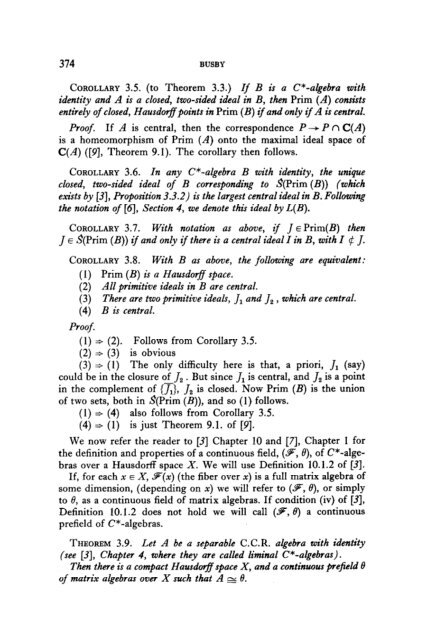On the Characters and the Plancherel Formula of Nilpotent Groups ...
On the Characters and the Plancherel Formula of Nilpotent Groups ...
On the Characters and the Plancherel Formula of Nilpotent Groups ...
You also want an ePaper? Increase the reach of your titles
YUMPU automatically turns print PDFs into web optimized ePapers that Google loves.
374 BUSBY<br />
COROLLARY 3.5. (to Theorem 3.3.) If B is a C*-akebra with<br />
identity <strong>and</strong> A is a closed, two-sided ideal in B, <strong>the</strong>n Prim (A) consists<br />
entirely <strong>of</strong> closed, Hausdogpoints in Prim (B) if <strong>and</strong> only if A is central.<br />
Pro<strong>of</strong>. If A is central, <strong>the</strong>n <strong>the</strong> correspondence P-+ P n C(A)<br />
is a homeomorphism <strong>of</strong> Prim (A) onto <strong>the</strong> maximal ideal space <strong>of</strong><br />
C(A) ([9], Theorem 9.1). The corollary <strong>the</strong>n follows.<br />
COROLLARY 3.6. In any C*-algebra B with identity, <strong>the</strong> unique<br />
closed, two-sided ideal <strong>of</strong> B corresponding to $(Prim (B)) (which<br />
exists by [3], Proposition 3.3.2) is <strong>the</strong> largest central ideal in B. Following<br />
<strong>the</strong> notation <strong>of</strong> [6], Section 4, we denote this ideal by L(B).<br />
COROLLARY 3.7. With notation as above, ;f J ~Prim(B) <strong>the</strong>n<br />
J E S(Prim (B)) if <strong>and</strong> only if th ere is a central ideal I in B, with I $ J.<br />
COROLLARY 3.8. With B as above, <strong>the</strong> following are equivalent:<br />
(1) Prim (B) is a HausdotJg space.<br />
(2) All primitive ideals in B are central.<br />
(3) There are two primitive ideals, J1 <strong>and</strong> Jz , which are central.<br />
(4) B is central.<br />
Pro<strong>of</strong>.<br />
(1) S- (2). Follows from Corollary 3.5.<br />
(2) =+ (3) is obvious<br />
(3) 3 (1) The only difficulty here is that, a priori, J1 (say)<br />
could be in <strong>the</strong> closure <strong>of</strong> Jz . But since J1 is central, <strong>and</strong> JS is a point<br />
in <strong>the</strong> complement <strong>of</strong> (x}, Jz is closed. Now Prim (B) is <strong>the</strong> union<br />
<strong>of</strong> two sets, both in &Prim (B)), <strong>and</strong> so (1) follows.<br />
(1) * (4) also follows from Corollary 3.5.<br />
(4) 3 (1) is just Theorem 9.1. <strong>of</strong> [9].<br />
We now refer <strong>the</strong> reader to [3] Chapter 10 <strong>and</strong> [A, Chapter 1 for<br />
<strong>the</strong> definition <strong>and</strong> properties <strong>of</strong> a continuous field, (9, 0), <strong>of</strong> C*-alge-<br />
bras over a Hausdorff space X. We will use Definition 10.1.2 <strong>of</strong> [3].<br />
If, for each x E X, F(x) (<strong>the</strong> fiber over x) is a full matrix algebra <strong>of</strong><br />
some dimension, (depending on x) we will refer to (9, e), or simply<br />
to 8, as a continuous field <strong>of</strong> matrix algebras. If condition (iv) <strong>of</strong> [3],<br />
Definition 10.1.2 does not hold we will call (9, 8) a continuous<br />
prefield <strong>of</strong> C*-algebras.<br />
THEOREM 3.9. Let A be a separable C.C.R. algebra with identity<br />
(see [3], Chapter 4, where <strong>the</strong>y are called h’minal (?-algebras).<br />
Then <strong>the</strong>re is a compact Hausdorff space X, <strong>and</strong> a continuous prefield 8<br />
<strong>of</strong> matrix algebras over X such that A g 8.

















